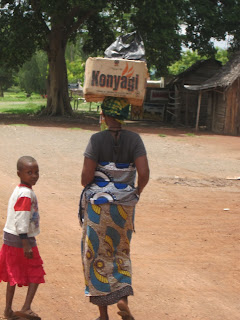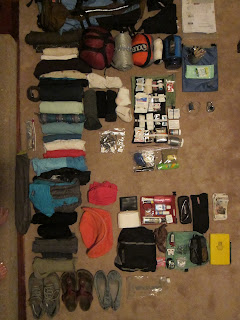Our first stop on safari in Tanzania was Lake Manyara National Park. This area is known for gathering animals together--everyone needs water. This is less pronounced in the rainy season, but there was still an abundance of animals that I hadn't really expected. The below picture is looking out towards the lake . . . you could see (but not discernibly without the binoculars) little pink dots which were thousands and thousands of flamingos along the water's edge.
On our way there from Arusha, we went through many small villages and again I was struck by the colours and life we saw. I took fewer pictures than I'd wanted, as it always felt a little wrong (even though throughout India I was a walking photograph).
Our truck was outfitted with an awesome opening roof, allowing us to stand and look out across the jungle/plains with windblown hair, while still remaining shaded from the sun. Oh how colonial I felt.
We saw many different herds of elephants throughout the day--very lucky, really. The photographs that follow are just a selection of the elephant bonanza photoshoot that went on.
An elephant stand-off
A little elephant love going on in front of our jeep. Adorable.
Then some elephant tree-eating.
Then some peeing. Love the wide-legged stance, and the modest facing of the bushes.
This area is really well known for baboons, and it was so much fun watching them interact in their family groupings. Such personality. You could even see them in groups across the plains.
Here's an example of my photograph/binocular technique. . . makes it feel a little Hemingway-esque, like I'm hunting game. Incidentally, Hemingway's Green Hills of Africa is written based on his trip to Lake Manyara. However, you won't find anyone hunting a rhino here these days, thankfully.
More hippos for Sarah Galbraith!
There were interesting birds that were quite friendly, especially while we were eating our lunches :)
That night we drove back into a wee village to camp for the night, safely surrounded by a walled structure. The camp had a cat, which decided to sleep by my tent in the middle of the night. If I hadn't seen it when I got up to go to the bathroom, I would have been pretty scared by it scratching on the wall of the tent by my head--wanting to be petted at 6am. First cat sighting of the trip :)
Yup, a little cross-eyed.
On our way there from Arusha, we went through many small villages and again I was struck by the colours and life we saw. I took fewer pictures than I'd wanted, as it always felt a little wrong (even though throughout India I was a walking photograph).
Our truck was outfitted with an awesome opening roof, allowing us to stand and look out across the jungle/plains with windblown hair, while still remaining shaded from the sun. Oh how colonial I felt.
We saw many different herds of elephants throughout the day--very lucky, really. The photographs that follow are just a selection of the elephant bonanza photoshoot that went on.
An elephant stand-off
A little elephant love going on in front of our jeep. Adorable.
Then some elephant tree-eating.
Then some peeing. Love the wide-legged stance, and the modest facing of the bushes.
This area is really well known for baboons, and it was so much fun watching them interact in their family groupings. Such personality. You could even see them in groups across the plains.
More hippos for Sarah Galbraith!
There were interesting birds that were quite friendly, especially while we were eating our lunches :)
That night we drove back into a wee village to camp for the night, safely surrounded by a walled structure. The camp had a cat, which decided to sleep by my tent in the middle of the night. If I hadn't seen it when I got up to go to the bathroom, I would have been pretty scared by it scratching on the wall of the tent by my head--wanting to be petted at 6am. First cat sighting of the trip :)
Yup, a little cross-eyed.




















































